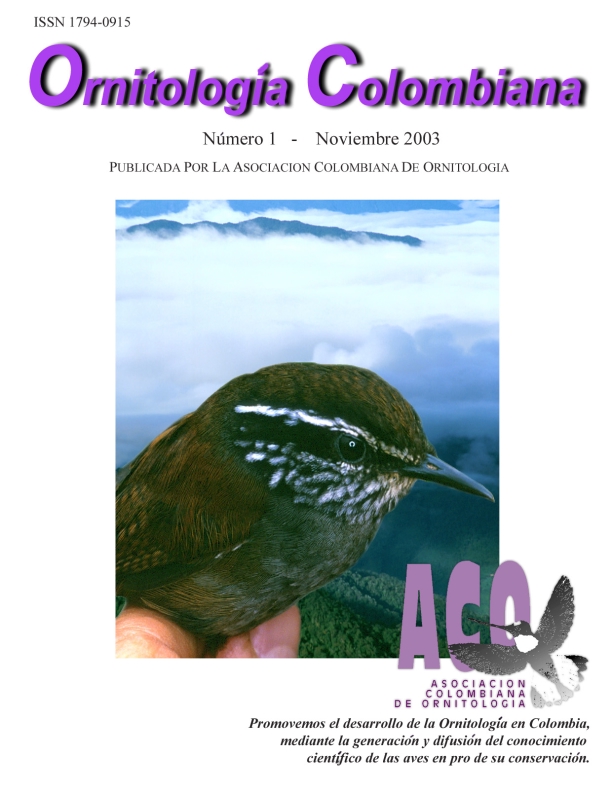Habitat use and diet of the Torrent Duck (Merganetta armata) in Ucumarí Regional Park in the Central Andes of Colombia
Habitat use and diet of the Torrent Duck (Merganetta armata) in Ucumarí Regional Park in the Central Andes of Colombia
DOI:
https://doi.org/10.59517/oc.e14Keywords:
Diet, habitat, Merganetta armata colombiana, Torrent DuckAbstract
Between July 1993 and December 1994, we estimated the population size of the Torrent Duck at the Ucumarí Regional Natural Park, characterized its habitat, and described some aspects of its feeding habits and diet. We found seven pairs of adult birds along a 15 km transect of the Otún River which crosses the Park. Both the frequency of observation of the birds at some sites, and the repeated findings of feces suggest that the population size remained constant during the study period. Our focal observations of two pairs of adults allowed us to calculate a mean length for their home ranges of 1400 m. Differences in some descriptive variables among ranges indicate some flexibility of the species in its habitat requirements. Sites occupied by the ducks differed from unoccupied sites only in the visibility to the nearest river bend. The diet of the Torrent Duck, determined from examination of feces, was dominated by immature aquatic insects, particularly Trichoptera. Although the diet was similar in composition to that of Rainbow Trout caught in the river, the null hypothesis of complete niche overlap among these species was rejected; this discards the likelihood of interspecific competition for food between them.
Downloads
References
Ball, I.J., P.G.H. Frost, W.R. Siegfried & F. Mckinney.1978. Territories And Local Movements Of African Black Ducks (Anas Sparsa). Wildfowl 29:61-79.
Borrero, J.I. 1952. Apuntes Sobre Aves Colombianas. Lozania 1:7-12.
Bottjer, P.D. 1983. Systematic relationships among the Anatidae: an immunological study, with a story of Anatid classification, and a system of classification. Ph.D. Diss., Yale University.
Brush, A.H. 1976. Waterfowl feather proteins: analysis of use in taxonomic studies. J. Zool. London 179:467-498.
Carboneras, C. 1992. Family: Anatidae. Pp. 536-628 in: del Hoyo, J., A. Elliot & J. Sargatal (Eds.). Handbook of the birds of the world, vol. 1. Lynx Edicions, Barcelona.
Collier, K.J. 1991. Invertebrate food supplies and diet of Blue Duck on rivers in two regions of the North Island, New Zealand. New Zealand Journal of Ecology 15:131-138.
Collier. K.J. & G.L. Lyon. 1991. Trophic pathways and diet of Blue Duck (Hymenolaimus malacorhynchus) on Manianulateao River: a stable carbon isotope study. New Zealand Journal of Marine and Freshwater Research 25:181-186.
Collier, K.J., S.J. Moralee & M.D. Wakelin. 1993. Factors affecting the distribution of Blue Duck Hymenolaimus malacorhynchus on New Zealand rivers. Biological Conservation 63:119-126.
Fjeldså, J. & N. Krabbe. 1990. Birds of the High Andes. University of Copenhagen, Copenhagen.
Hilty, S.L. & W.L. Brown. 1986. A guide to the birds of Colombia. Princeton Univ. Press, Princeton.
Johnsgard, P.A. 1966. The biology and relations of the Torrent Duck. Wildfowl Trust Ann. Rept. 17:66-74.
Kear, J. 1975. Salvadori’s Duck of New Guinea. Wildfowl 26: 104-111.
Kear, J. & P.J.K. Burton. 1971. The food and feeding apparatus of the Blue Duck Hymenolaimus malacorhynchus. Ibis 113:483-493.
Ludwig, J. A. & J. F. Reynolds. 1988. Statistical Ecology. John Wiley & Sons, New York.
Madge, S. & H. Burn. 1988. Wildfowl. Christopher Helm, London.
Mckinney, F., W.R. Siegfried, L.J. Ball & P.G.H. Frost. 1978. Behavioral specializations for river life in the African Black Duck (Anas sparsa). Z. Tierpsychol. 48:349-400.
Moffet, G.M. 1970. A study of nesting Torrent Ducks in the Andes. The Living Bird 9:5-27.
Phelps, W.H. & R. Meyer De Schauensee. 1978. Una guía de las aves de Venezuela. Talleres de Gráficas Armitano, C.A., Caracas.
Rose, P.M. & D.A. Scott (Eds.). 1997. Waterfowl popul ation estimates, 2nd Ed. Wetlands International Publ. 44, Slimbridge.
Sibley, C.G., J.E. Ahlquist & B.L. Monroe, Jr. 1988. A classification of the living birds of the world based on DNA-DNA hybridization studies. Auk 105:409-423.
Siegfried, W.R. 1968. The Black Duck in the South-western Cape. Ostrich 39:61-75.
Woolfenden, G.W. 1961. Postcranial osteology of the waterfowl. Bull. Fla. State Mus. Biol. Sci., 129 pp.
Downloads
Published
Issue
Section
License

This work is licensed under a Creative Commons Attribution-NonCommercial 4.0 International License.





